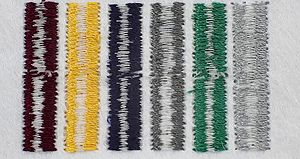Difference between revisions of "Embroidery Troubleshooting"
| Line 11: | Line 11: | ||
One of the most common problems encountered in daily embroidery production is a thread break. This section covers the main reasons that a thread will break and how to minimize thread breaks. The six problem areas involve: thread, needles, materials, design, mechanics and operator technique. | One of the most common problems encountered in daily embroidery production is a thread break. This section covers the main reasons that a thread will break and how to minimize thread breaks. The six problem areas involve: thread, needles, materials, design, mechanics and operator technique. | ||
[[File:embroidery_machine_tension_test.jpg|right|alt=Tensions Test|Tensions Test]] | [[File:embroidery_machine_tension_test.jpg|thumb|right|alt=Tensions Test|Tensions Test]] | ||
;Tensions: The tensions should constantly be checked on the machine. If the tensions are off, the machine might break threads. For more information on setting the tensions, read [[Embroidery_Machine_Service_Guide#Tensions|Embroidery Machine Service Guide - Tensions]] | ;Tensions: The tensions should constantly be checked on the machine. If the tensions are off, the machine might break threads. For more information on setting the tensions, read [[Embroidery_Machine_Service_Guide#Tensions|Embroidery Machine Service Guide - Tensions]] | ||
Revision as of 19:52, 29 August 2013
When an embroidery machine is not running at optimal performance there are certain Embroidery Troubleshooting tips one can follow to attempt to get the embroidery machine to run properly.
Before calling your embroidery machine technician, this troubleshooting guide might be used to fix basic problems.
When an embroidery machine becomes problematic chances are its not the machine but instead more than likely operator errors, design problems, hooping problems, thread or needle issues, etc. Before mechanically doing anything to your machine, one should check for most of the common issues.
Symptoms and Resolutions
Thread Breaks
One of the most common problems encountered in daily embroidery production is a thread break. This section covers the main reasons that a thread will break and how to minimize thread breaks. The six problem areas involve: thread, needles, materials, design, mechanics and operator technique.
- Tensions
- The tensions should constantly be checked on the machine. If the tensions are off, the machine might break threads. For more information on setting the tensions, read Embroidery Machine Service Guide - Tensions
Thread.
Needle.
Materials.
Design.
Mechanical.
Technique.
Needle Breaks
Needle breaks are another common issue. Here are some likely causes:
• The needle may be dull and needs to be changed. If the needle has trouble getting through the fabric, it will eventually cause the needle to break.
• Make sure the needle is inserted properly. If it is not inserted all the way into the needle bar shaft, it could come loose while sewing and break.
• Make sure the hook timing is correct. If the machine is not timed properly, the needle may hit the hook, which could cause it to break.
Bird Nesting
There are three primary causes to birdnesting: unbalanced tension, flagging, or problems with the hook assembly.
Tension problems. Check the thread path to insure the machine is threaded properly. Then sew a tension test such as an 18mm capital "I" test.
Flagging problems. Check to make sure the fabric is framed properly. It should be tight. Also, make sure there is not a significant gap between the hoop assembly and the sewing arm.
Hook assembly problems. If there is a problem with the hook assembly, look at two things. Either the hook positioning finger is mounted too close to the hook basket, or the hook basket does not allow the sewing hook to spin freely.
Skipping Stitches
Vibrations and Noise
When an embroidery machine vibrates excessively then it might mean the machines is not on a flat surface or is not properly leveled.
False Thread Breaks
Tools Recommended
Having the right tools is not only important for an embroidery machine technician but also for the embroidery machine operator.
